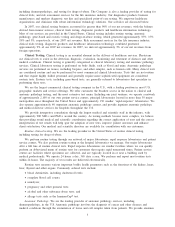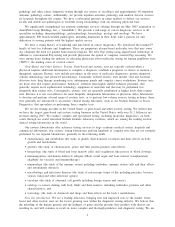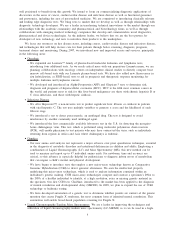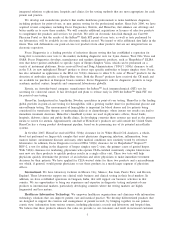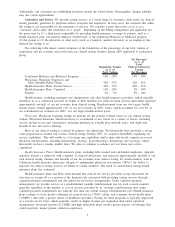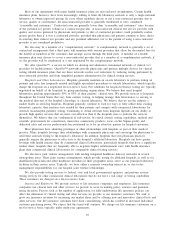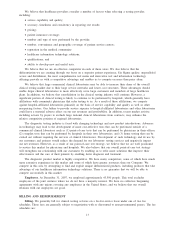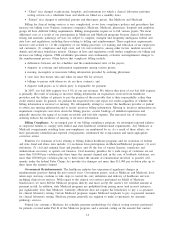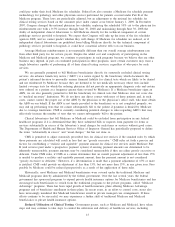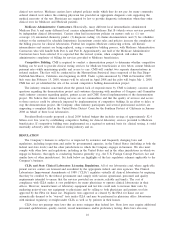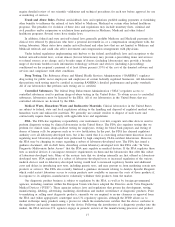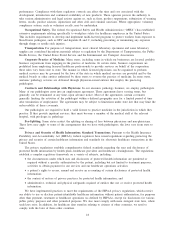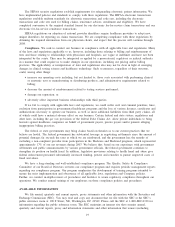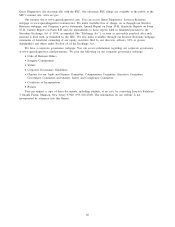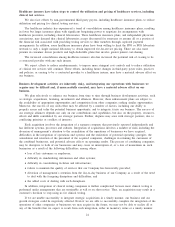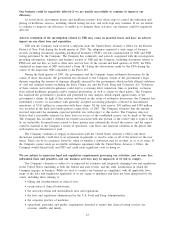Quest Diagnostics 2007 Annual Report Download - page 22
Download and view the complete annual report
Please find page 22 of the 2007 Quest Diagnostics annual report below. You can navigate through the pages in the report by either clicking on the pages listed below, or by using the keyword search tool below to find specific information within the annual report.We believe that healthcare providers consider a number of factors when selecting a testing provider,
including:
•service capability and quality;
•accuracy, timeliness and consistency in reporting test results;
•pricing;
•patient insurance coverage;
•number and type of tests performed by the provider;
•number, convenience and geographic coverage of patient service centers;
•reputation in the medical community;
•healthcare information technology solutions;
•qualifications; and
•ability to develop new and useful tests.
We believe that we are an effective competitor in each of these areas. We also believe that the
differentiation we are creating through our focus on a superior patient experience, Six Sigma quality, unparalleled
access and distribution, the most comprehensive test menu and innovative test and information technology
offerings provide us with a competitive advantage and enables us to compete on more than price alone.
We believe that large commercial clinical laboratories may be able to increase their share of the overall
clinical testing market due to their large service networks and lower cost structures. These advantages should
enable larger clinical laboratories to more effectively serve large customers and members of large healthcare
plans. In addition, we believe that consolidation in the clinical testing industry will continue. However, a
significant portion of clinical testing is likely to continue to be performed by hospitals, which generally have
affiliations with community physicians that refer testing to us. As a result of these affiliations, we compete
against hospital-affiliated laboratories primarily on the basis of service capability and quality as well as other
non-pricing factors. Our failure to provide service superior to hospital-affiliated laboratories and other laboratories
could have a material adverse effect on our net revenues and profitability. In addition, recent market activity,
including actions by payers to exclude large national clinical laboratories from contracts, may enhance the
relative competitive position of regional laboratories.
The diagnostic testing industry is faced with changing technology and new product introductions. Advances
in technology may lead to the development of more cost-effective tests that can be performed outside of a
commercial clinical laboratory such as (1) point-of-care tests that can be performed by physicians in their offices;
(2) complex tests that can be performed by hospitals in their own laboratories; and (3) home testing that can be
carried out without requiring the services of clinical laboratories. Development of such technology and its use by
our customers and patients would reduce the demand for our laboratory testing services and negatively impact
our net revenues. However, as a result of our point-of-care test strategy, we believe that we are well positioned
to service this market for physicians and hospitals. We also believe that our overall point-of-care test strategy
will strengthen our relationship with our customers by enabling us to offer more solutions that improve their
effectiveness and the care of their patients by enabling faster diagnosis and treatment.
The diagnostic product market is highly competitive. We have many competitors, some of which have much
more extensive experience in this market and some of which have greater resources than our Company. We
compete in this area by attempting to find and exploit unique differentiated products, including products that take
advantage of our healthcare information technology solutions. There is no guarantee that we will be able to
compete successfully in this market.
Employees. At December 31, 2007, we employed approximately 43,500 people. This total excludes
employees of the joint ventures where we do not have a majority interest. We have no collective bargaining
agreements with any unions covering any employees in the United States, and we believe that our overall
relations with our employees are good.
BILLING AND REIMBURSEMENT
Billing. We generally bill for clinical testing services on a fee-for-service basis under one of two fee
schedules. These fees are generally subject to negotiation with or discounted to non-governmental payers. The fee
schedules are:
13


